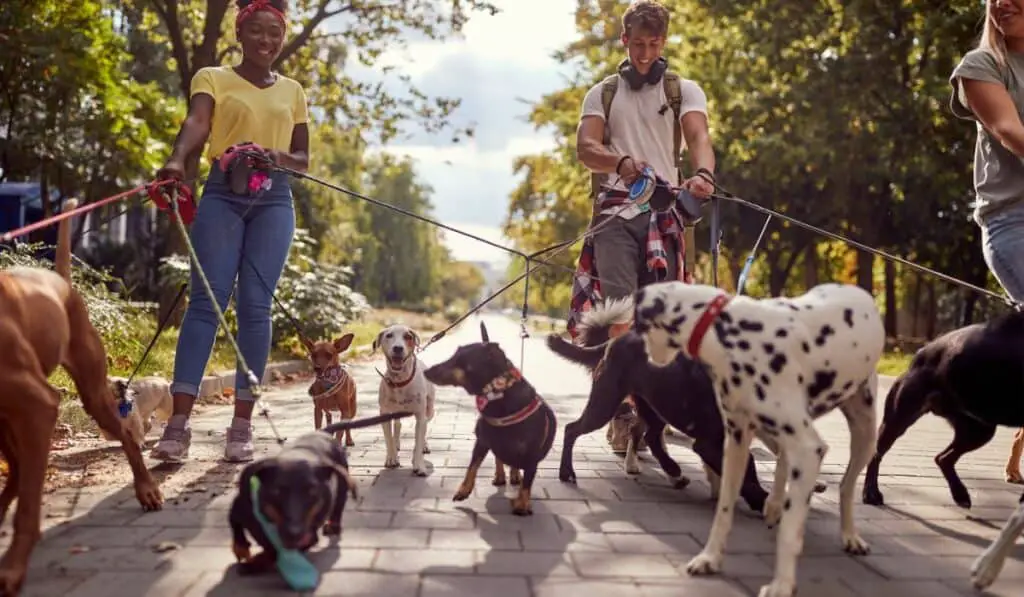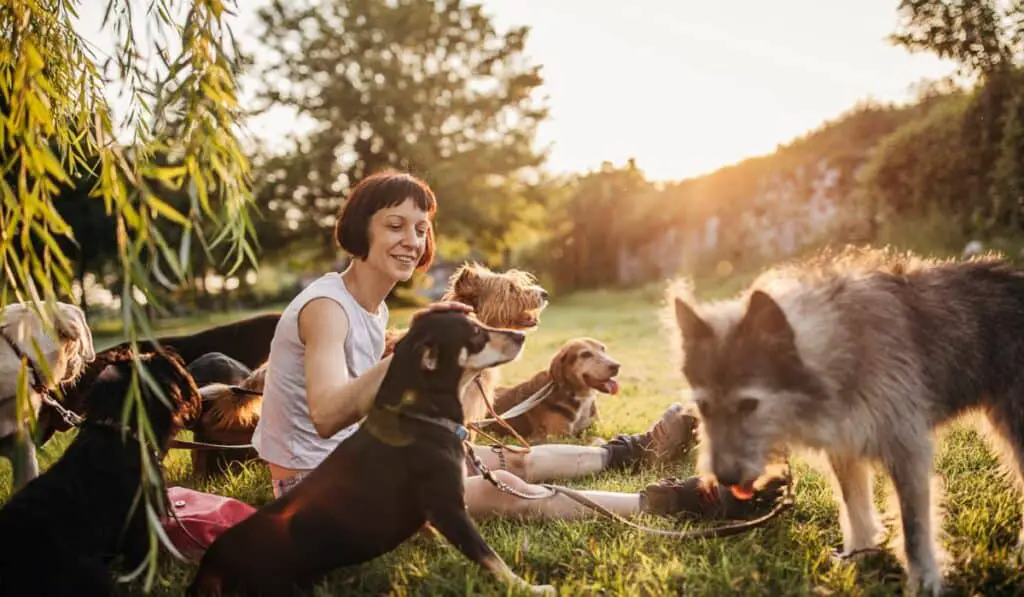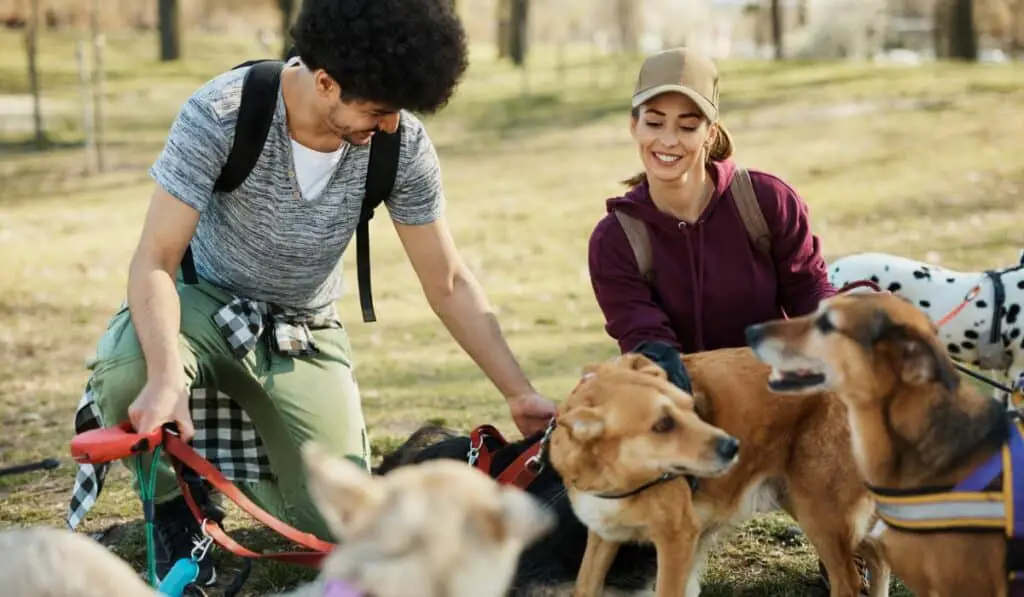If you’re someone with a genuine love for dogs and dreams of turning that passion into a rewarding career, becoming a dog walker could be an ideal choice. This profession not only allows you to spend time with adorable furballs but also provides an opportunity to transform your affection for canines into a fulfilling source of income.
In this article, we’ll delve into the steps you can take to kick start this journey. By blending your love for dogs with professionalism and reliability, you can certainly turn your passion into a gratifying and fulfilling career.
How To Become A Dog Walker
1. Get The Required Skills And Experience
Before you become a dog walker, it’s good to learn about dogs and their care. Begin by volunteering at a local animal shelter, where you can spend time with various dogs to observe their behaviors and needs. Doing this hands-on work helps you get more comfortable with different situations.
Another way to learn is by working with experienced dog walkers. These individuals have extensive experience in the field where you can watch and learn helpful tips and tricks from them.

To show clients that you really care about their pets, think about getting certifications in first aid and CPR for dogs. This not only underscores your commitment to their safety but also equips you with essential skills to handle potential issues, making you a reliable and trusted dog walker.
2. Learn The Responsibilities
Being a dog walker involves more than just walks; it requires dedication and effective communication with clients. Discussing walk schedules, preferred routes, and any special considerations about their pets ensures clarity and collaboration for a successful experience.
Safety is prioritized by using collars with tags and keeping dogs on a leash. Learning basic commands is essential for effective control during walks, contributing to a positive experience for everyone involved. Additionally, taking care of their overall well-being by providing proper nutrition and occasional treats ensures the dogs are safe, happy, and healthy.
3. Find The Right Rate
To set a competitive price for your dog walking services, research rates charged by other walkers in your area. Consider factors like the number of dogs and distance covered when determining your fee. If you provide additional services like feeding or grooming, factor those into your pricing.
Tailoring fees based on individual client needs ensures fair treatment and keeps you competitive in the local pet care market. Regularly review and adjust your rates to align with the value of your services and stay current with market trends.
4. Promote Your Service
To attract more clients, ensure your promotional materials, such as business cards and flyers, are visually appealing and effectively communicate your dog walking skills. Showcase your experience, certifications, and unique offerings to make your services stand out.

Utilize social media platforms like Instagram, Facebook, or X (Twitter) to expand your reach. Share engaging content about your dog walks, such as pictures or videos, and actively interact with potential clients by answering their questions and promoting your services. Establishing an online presence helps more people know about you and what you can do as a dog walker.
5. Building A Client Base
Kickstart your dog walking business by assisting friends, family, and neighbors with their dogs. Good reviews and recommendations from happy clients are super important for growing your network. Ask them to share their positive experiences, and this can help bring in more clients.
To reach a wider audience, explore online platforms and apps designed for pet care services. Signing up on these platforms not only gets you more clients but also enhances your visibility in the pet care community. Utilize these online spaces to showcase your expertise, share testimonials, and build a strong presence in the pet care industry.
6. Managing Scheduling And Bookings
When managing your schedule, use a calendar to note down appointments, cancellations, and any changes. Set clear boundaries and create a routine that works for both you and your clients. This helps you manage your time effectively and ensure you can balance your work and personal life.
Improve your time management by grouping appointments in the same areas. This reduces travel time between walks and makes your schedule more efficient. By doing this, you can make the most of your working hours and run a more organized and productive dog walking business.
7. Operations And Day-To-Day Management
Besides walking dogs, managing operational tasks is crucial for running a successful dog walking business. This involves things like billing clients, tracking expenses, and keeping thorough records. Doing these tasks efficiently helps you stay organized and clear about your finances, which is important for taxes and overall business management.

It’s also a good idea to take steps to protect your business legally. Getting a business license gives you official recognition for your services, and investing in liability insurance is smart because it protects both you and your clients if something unexpected happens.
By staying on top of these operational and legal matters, you can run your dog walking business smoothly and confidently, knowing that you’re taking care of both your clients and yourself.
8. Choosing The Right Equipment
To run a successful dog walking business, it’s important to have the right gear. Start with strong collars and leashes that keep both you and the dogs safe during walks. Get comfortable walking shoes to stay focused and have a good time during walks.
Use treat bags to reward good behavior and keep the dogs interested in the walk. Also, have waste bags for cleaning up responsibly, showing that you care about a clean environment.
Having the proper gear not only makes your job easier but also shows your clients that you’re serious and professional. It tells them that you’re ready to keep their pets safe and happy, making you a trustworthy dog walker.
9. Growing Your Dog Walking Service
To grow your dog walking business, consider offering extra services like grooming or pet sitting. This makes your business more helpful to pet owners, like a one-stop shop for all their needs. Providing additional services could attract more customers and help your business grow.
Connect with other dog walkers to learn from their experiences and maybe collaborate on bigger projects. Being part of a group keeps you informed about what’s happening in the world of dog care, opening up more job opportunities and partnerships to make your business stronger.
Keep learning about taking care of pets by attending workshops, classes, or watching online videos. This helps you become better at your job, and people appreciate it when you know a lot about pets, making your dog walking business more trustworthy.

Get the 7 Biggest Training Mistakes free report!
What Skills Do I Need To Become A Dog Walker?
As a dog walker, you’ll need a combination of practical skills and soft skills to excel in the role. Let’s dive into the key skills you should develop.
Experience With Dogs
To be a great dog walker, you should really love dogs and feel comfortable around them. It’s also good to know about different types of dogs and their temperament. If you’re new to dog walking, try volunteering at an animal shelter or walk your neighbors’ dogs.

This hands-on experience boosts your confidence and helps you understand dogs better. It’s like making new friends! This way, you can make every walk a fun and enjoyable experience for your furry friends.
Physical Fitness
Physical fitness is vital for a dog walker due to several reasons. It ensures endurance for covering significant distances during walks and handling the lively energy of dogs effectively. Physical strength, particularly in the upper body, becomes beneficial when dealing with larger breeds, maintaining control and ensuring a safe experience.
Moreover, being physically fit enables a quick and effective response to unexpected situations or emergencies, ensuring the safety of both the dogs and the walker.
Reliability
Being on time and sticking to schedules is super important for a dog walker. Pet owners trust you to take good care of their furry friends, so being reliable is key. When you’re known for always being there when you say you will, it helps build a strong reputation. This reliability not only keeps your current clients happy but also attracts new ones, helping your dog walking business grow.
Communication
As a dog walker, good communication is really important. Talking openly with pet owners about their dog’s behavior helps everyone understand what to expect, and you can adjust your approach for each dog. Regular updates during walks keep owners informed and reassured. If issues come up, talking to owners right away builds trust and allows for problem-solving together.

Being a good listener and understanding both dogs and owners helps build strong relationships based on trust. So, prioritizing communication ensures a positive experience for both dogs and owners during every walk.
Adaptability
Each dog is unique, with specific needs and preferences. Adapting your walking style, pace, and route to meet each pet’s requirements ensures a comfortable and enjoyable experience for them.
Some dogs may prefer a leisurely stroll, while others may need a more energetic walk. This adaptability helps build a positive relationship between the dog and the walker. Similarly, flexibility with scheduling is crucial to accommodate the diverse routines and preferences of both dogs and their owners, contributing to a smoother and more effective dog walking service.
Basic Dog Training Knowledge
While it’s not a must, knowing about dog training techniques can really help when dealing with dogs, especially if they act up during walks. Understanding how to handle common problems like pulling on the leash or excessive barking makes the walk better for both you and the dogs. It’s like having an extra tool to ensure a positive and controlled walk. This knowledge adds to the overall quality of your dog walking service, making things smoother and more enjoyable for everyone involved.
Business Skills
If you want to make dog walking your full-time job, it’s essential to have some basic business skills. These skills empower you to effectively manage your finances, ensuring a sustainable and profitable venture. Creating organized schedules ensures that you can efficiently handle multiple clients and appointments.
Additionally, mastering basic marketing strategies allows you to promote your dog walking services successfully, attracting a broader clientele and contributing to the growth and success of your business. Overall, a solid grasp of business essentials enhances your ability to run a successful and thriving dog walking enterprise.
Here’s a summary of the key skills needed to become a dog walker:
| Skill | Importance |
| Experience with animals | Familiarity with breeds, temperaments, and handling |
| Physical fitness | Stamina, endurance, and strength |
| Reliability | Punctuality, scheduling, and trustworthiness |
| Communication | Empathy, active listening, and rapport-building |
| Adaptability | Flexible walking styles, paces, and routes |
| Dog training knowledge | Managing undesirable behaviors, basic obedience |
| Business skills | Financial management, scheduling, and marketing |
Final Thoughts

In brief, effective dog walkers require a sincere love for dogs, a profound comprehension of canine behavior, and a high level of physical fitness. Proficiency in dog first aid is essential for handling unforeseen situations and ensuring the well-being of the dogs.
While formal education is not obligatory, platforms like Rover and Wag! offer opportunities for aspiring dog walkers to connect with clients and receive support. Keep in mind that different cities may have varying regulations, so it’s essential to familiarize yourself with your local rules before stepping into the dog walking world.
